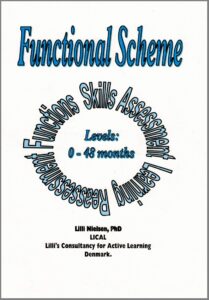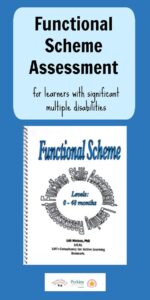Assessment
Functional Scheme and Other Assessment Tools
The Functional Scheme assessment and re-assessment tool was developed by Dr. Nielsen to meet the needs of children and adults with multiple special needs who are functioning at a developmental level under 48 months. The purpose of the tool is to create the best possible basis for developing an appropriate learning program for the individual.
It is important to note that additional assessment tools can be combined with the Functional Scheme as part of the child’s assessment process. So for example the physical therapist, speech-language therapist, orientation and mobility specialist, vision teacher and others may use some other testing tools in their individual assessment process. In the Functional Scheme, Lilli left blank spaces for specific skills from these instruments to be included when appropriate. For example, we especially like to use information gathered from the Communication Matrix from Design to Learn for use in looking at language development.
The greatest benefit of the Functional Scheme is the detailed listing of skills beginning from birth through 48 months. Many other assessments do not offer this type of information to help in program planning. With many of these children, progress seems to take a very long time and it is hard to see the progress the child makes toward achieving goals and benchmarks. The Functional Scheme lists specific skills at each developmental level that can be tracked easily making progress documentation a much easier task.
Areas of Assessment
The Functional Scheme assesses these areas of development:

Functional Scheme: Functions Skills Assessment Learning Reassessment Levels 0-48 months
- Gross Movement
- Fine Movement
- Mouth Movement
- Visual Perception
- Auditory Perception
- Haptic-tactile Perception
- Smell and Taste
- Spatial Perception
- Object Perception
- Language verbal
- Language non-verbal,
- Language comprehension
- Social Perception
- Emotional Perception
- Play and Activities
- Toileting Skills
- Undressing & Dressing Skills
- Personal Hygiene
- Eating Skills
The Functional Scheme also evaluates skills that occur irrespective of a developmental level, and learned behaviors (such as poking eyes, tactile defensiveness, biting, hitting, etc.) that may impede developmental learning.
Functional Scheme Assessment Summary

The Functional Scheme areas of assessment are broken down into development skills in increments of 3 – 6 months beginning at birth and continuing through age 4 years as observed in an individual with multiple special needs. When the information is compiled using the Functional Scheme Assessment Summary you have a very good picture of where the child is developmentally.
After determining a person’s functional level, appropriate individualized programming can be developed using the best materials, perceptualizing aides and equipment, and phase of educational treatment. The FIELA Curriculum aligns with these developmental levels to help in developing a schedule of activities for the child’s day.
The Functional Scheme helps the evaluator to re-assess the current learning program. The same book can be used to assess many individuals throughout their lifetime. The evaluator can identify what skills are emerging, performed under favorable conditions, or performed spontaneously.
Ideally this assessment should be completed by the individual’s educational team working together with the parents or caregivers. The initial evaluation will take some time, but once it is completed, ongoing re-assessment is easy. This tool provides a concise record of the child’s progress in the various developmental areas.
The Functional Scheme Assessment is available through LilliWorks.
Patty Obrzut Discusses the Functional Scheme Assessment
Original webcast date: 12/01/2016
Description: The Functional Scheme: Assessing the Developmental Level of special needs students


